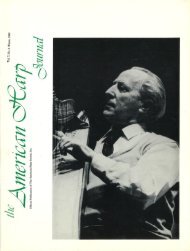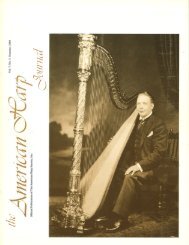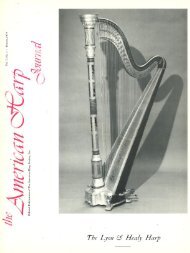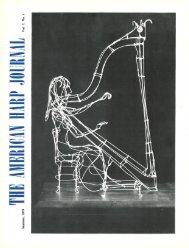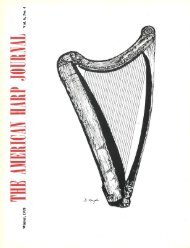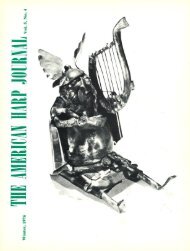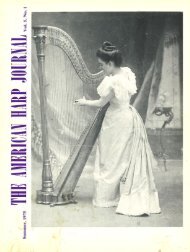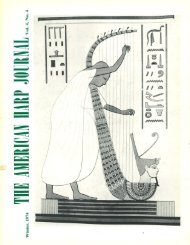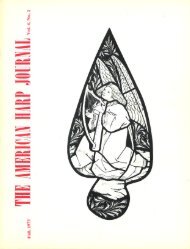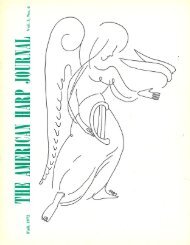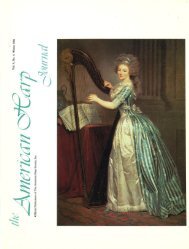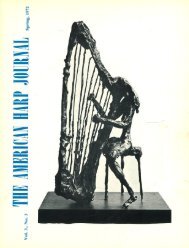Create successful ePaper yourself
Turn your PDF publications into a flip-book with our unique Google optimized e-Paper software.
Jefferson in a letter to his daughter from Philadelphia<br />
in 1800:<br />
"A very ingenious, modest, and poor young man in<br />
Philadelphia has invented one of the prettiest improvements<br />
in the pianoforte that I have seen, and it<br />
has tempted me to engage one for Monticello. His<br />
strings are perpendicular ... "<br />
Singleton comments that this instrument must have been<br />
similar to the 'keyed harp' or 'piano-harp' which Guttwald,<br />
75 Maiden Lane, Philadelphia, advertised in the<br />
Evening Post in 1818 (" ... a musical instrument that<br />
perfectly equals the harp in sound and far surpasses it<br />
in easy treatment). 41<br />
THE HARP IN THE UNITED ST A TES<br />
SINCE 1835-A BRIEF RESUME<br />
Lyon and Healy of Chicago became the largest importers<br />
of harps during the 19th century, handling such<br />
European makes as Erard, Erat, Dodd, Grospian,<br />
Nadermann, and Meyer. In 1889, the first Americanmade<br />
Lyon and Healy harp was manufactured. 42<br />
The Boston Symphony Orchestra had one harpist<br />
among its personnel when it was established in 1881;<br />
and a second was added to the payroll in the season of<br />
1918-19 (when Henri Rubaud was conducting). A<br />
harpist was presented as soloist with the orchestra as<br />
early as 1883 ; 43 and in 1884, Mozart's Concerto for<br />
Flute and Harp in C was included in the program of<br />
January 12. 44<br />
In New York, the year 1859 saw a performance of<br />
Liszt's Les Preludes by the Philharmonic Society; if it<br />
was played as scored, there was a harpist in the orchestra.<br />
45<br />
Early U.S. performances of several major works with<br />
harp, taking place after the turn of the 20th century,<br />
include:<br />
Widor, "Chorale and Variations": 1902, Chicago<br />
Symphony Orchestra 40<br />
Ravel, "Introduction and Allegro": 1916, Symphony<br />
Society of New York 47<br />
Debussy, "Two Dances for Harp and Orchestra" (with<br />
pedal harp): 1917, Carnegie Hall, New York 48<br />
As for the last of these, it was given a first chromaticharp<br />
performance in New York on December 2 7, 1 919,<br />
by Mme. Wurmser-Delcourt, who had premiered the<br />
work in Paris in 1904. (She was the best-known of the<br />
performers who championed the chromatic harp, as opposed<br />
to the pedal harp, in the early years of this century.)<br />
In this American debut, Mme. Wurmser-Delcourt<br />
was featured with the Symphony Society of New<br />
York. 49 As important harpists appeared on the scene in<br />
the late 19th and early 20th centuries, many of them<br />
were men; and very few of them were American-born.<br />
Among the names of orchestral players, harpist-composers,<br />
soloists, and pedagogues, we recognize Heinrich<br />
Schuecker, Alfred Holy, Carlos Salzedo, Marcel<br />
Grandjany, Salvatore Mario de Stefano, Alberto<br />
Salvi, and others. They have produced as students many<br />
outstanding American harpists. One of the first of these,<br />
a student of Schuecker, was Van Veachton Rogers<br />
8<br />
(1864-1937), who had a very successful 'free-lancing'<br />
career with the harp. He toured the country for a number<br />
of seasons with the noted mime-narrator, Charles T.<br />
Grilley,50 performing background music. Possibly this<br />
was the beginning of the use of the harp for that purpose,<br />
leading to its later popularity in radio, television,<br />
movies, and the theater.<br />
The first half of the 20th century saw the development<br />
of harp departments in conservatories and universities;<br />
the staging of large harp festivals; tours by<br />
ensembles of harps, chamber music groups using harp,<br />
and solo harpists; summer harp study colonies and<br />
workshops; and numerous new solo compositions and<br />
works scored for harp in the orchestra. As the recording<br />
industry developed, the public became increasingly<br />
familiar with the harp repertoire. An interest in folk<br />
music has brought folk harp builders and players into<br />
prominence, beginning with the Melville Clark Irish<br />
harp, patented in 1911, 51 and increasing until today the<br />
Folk Harp Journal lists scores of devotees throughout<br />
the country. 52 More and more instruments, of traditional<br />
as well as modem design, and in many sizes, are being<br />
built and/or imported by Lyon and Healy, Salvi, and<br />
Venus Harp Companies. There are harp offerings in<br />
many public schools. Electronically-amplified harps<br />
have taken their place in the world of popular music;<br />
and serious avant-garde composers are scoring in innovative<br />
ways for harp. A new generation of harpists,<br />
American-born, has come into prominence.<br />
As we look at these developments from the perspective<br />
of <strong>1976</strong>, the pace seems to have quickened,<br />
and it is apparent that a great deal of progress has taken<br />
place. As with all phases of music, the media have<br />
played an enormous role in the surge of interest in the<br />
harp in America. Without a doubt, another major source<br />
of impetus has been the American Harp Society, at<br />
least in the last decade-with its emphasis on performance,<br />
education, competitions, and the commissioning<br />
of new works.<br />
Whatever its future course, the harp has certainly<br />
joined the mainstream of American musical life in a<br />
permanent way.<br />
On the following 3 pages is a copy of the "Symphony<br />
Society Bulletin" of New York, dated December 27,<br />
1919. Walter Damrosch was the conductor of the New<br />
York Symphony Orchestra at that time.<br />
Included in the bulletin is a program featuring Mme.<br />
Wurmser-Delcourt playing the Debussy Danses and<br />
the Pieme Concertstuck on the chromatic harp. Also<br />
included are commentaries on both the harp and the<br />
music.<br />
AMERICAN HARP JOURNAL




